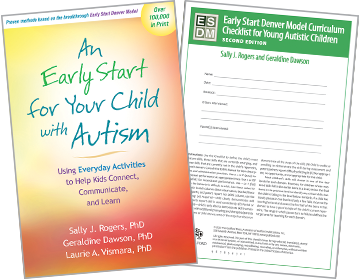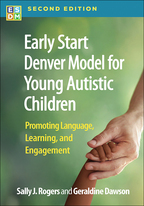Early Start Denver Model for Young Autistic Children
Second Edition
Promoting Language, Learning, and Engagement
Sally J. Rogers and Geraldine Dawson

New to This Edition
- Chapters on what to do when a child’s progress is concerning, partnering with families, and implementation of ESDM in different countries and cultures.
- Significant new research on brain development and how it differs in autism.
- Updated and comprehensive approach to promoting language development, with increased attention to alternative and augmentative communication strategies.
- New and revised decision trees and expanded efficacy research.
- Focus on promoting autistic children’s development from a neurodiversity-affirming perspective.
“ESDM, through its integrative approach to naturalistic, developmental–behavioral intervention, represented a paradigm shift for providers and caregivers when it first appeared. The second edition of this manual and the companion Checklist expand the focus to younger children, among other revisions. All of us who work with and care about young autistic children will gain from ESDM’s innovative methods. The manual is filled with strategies leading to learning and fun, descriptions of activities and everyday materials that make the strategies possible, and insightful reminders of what we are trying to accomplish. The Checklist is essential for planning and monitoring goals in ESDM and is also an invaluable supplement to more traditional assessments for practitioners who want to get a better sense of a child’s emerging skills and intervene accordingly.”
—Catherine Lord, PhD, ABPP, George Tarjan Distinguished Professor of Psychiatry and Education, David Geffen School of Medicine, University of California, Los Angeles
“Rogers and Dawson are true giants in the field of autism and state-of-the-art intervention—and this book demonstrates why. ESDM is clearly and methodically presented in a way that is readily accessible to clinicians, researchers, and educators. I am particularly impressed by the emphasis on how sound research has informed—and continues to inform—the ongoing development and improvement of ESDM. The book fosters a real understanding of the ‘why’ as well as the ‘how’ of implementation. This is so important and leads to better intervention use. Anyone involved in the study or treatment of young children with autism must have this book in their library.”
—Laura Schreibman, PhD, Emeritus Distinguished Professor, Department of Psychology, University of California, San Diego
“The second edition of the ESDM manual and checklist provide comprehensive, detailed information to powerfully support the growth and development of young autistic children. The manual includes important, helpful overviews of the current research base and an increased focus on neurodiversity-affirming care. It offers updated findings and recommendations related to intervention dosage, the use of alternative and augmentative communication strategies, and goal setting to enhance children’s quality of life.”
—Zachary Warren, PhD, Professor of Pediatrics, Psychiatry and Behavioral Sciences, and Special Education, Vanderbilt University
“ESDM is recognized as one of the leading naturalistic, developmental–behavioral interventions in the global autism community. The second edition of the core ESDM manual draws on the authors’ remarkable theoretical and clinical expertise and reflects the changing landscape of the field. The second edition’s specific focus on working with parents and families (who are ultimately the most important support and intervention partners) and the framing of ESDM in a neurodiversity-affirmative way are very powerful. It is very exciting to see how the intervention approach has been translated into so many different languages and cultural contexts. Further, these authors know how to write! Chapters are well structured and detailed, and feature excellent practical information, case examples, checklists, and stories.”
—Petrus J. de Vries, MBChB, FRCPsych, PhD, Director, Centre for Autism Research in Africa, University of Cape Town, South Africa
Table of Contents
Preface
1. What Brain Science Tells Us about How Young Autistic Children Learn
2. An Overview of the Early Start Denver Model
3. Setting Up the Early Start Denver Model
4. Developing Short-Term Learning Objectives
5. Formulating Daily Teaching Targets and Tracking Progress
6. Developing and Conducting an Early Start Denver Model Session
7. Developing Intentional Communication
8. Promoting Children’s Language Development
9. Developing Imitation and Play
10. When a Child’s Rate of Progress Is Concerning
11. Partnering with Families
12. Using the Early Start Denver Model in Group Settings
13. Using the Early Start Denver Model in Varying Cultures
Appendix. Early Start Denver Model Intervention Fidelity Coding Sheet
References
Index
About the Authors
Sally J. Rogers, PhD, is Distinguished Professor Emeritus of Psychiatry at the MIND Institute, UC Davis Health, University of California, Davis. A developmental psychologist, she has been involved at the international level in major clinical and research activities on autism for many decades. She has served as president of the International Society for Autism Research (INSAR) and was a member of the DSM-5 Work Group on autism and other neurodevelopmental conditions. Dr. Rogers has spent her entire career studying cognitive and social-communicative development and intervention in young children with disabilities and has published over 300 scientific papers, books, and chapters. As a licensed psychologist, she has provided clinical care to hundreds of infants and young children and their families in Michigan, Missouri, Colorado, and California. Dr. Rogers is a Fellow of the American Psychological Association, the Association for Psychological Science, and INSAR, and has received numerous awards for her contributions to the field of developmental disabilities. She is ranked in the top 1% of Clarivate Analytics Highly Cited Researchers.Geraldine Dawson, PhD, is the William Cleland Distinguished Professor of Psychiatry and Behavioral Sciences, Professor of Pediatrics, and Professor of Psychology and Neuroscience at Duke University, and is founding Director of the Duke Center for Autism and Brain Development. She also directs the Duke NIH Autism Center of Excellence. A child psychologist and researcher, Dr. Dawson has published more than 400 articles and chapters and 13 books on early autism detection and intervention and brain development. Her studies have been recognized as among the top 20 annual advances in autism research by the National Institutes of Health 13 times. Dr. Dawson has served as president of the International Society for Autism Research (INSAR) and was the first Chief Science Officer for Autism Speaks, the largest autism science and advocacy organization. She is a member of the American Academy of Arts and Sciences and a Fellow of the American Psychological Association, the Association for Psychological Science, and INSAR, and has received numerous awards for her contributions to research. She is ranked in the top 1% of Clarivate Analytics Highly Cited Researchers.
Audience
Early intervention specialists, including early childhood professionals and special educators, clinical child psychologists, applied developmentalists, behavior analysts, child psychiatrists, speech–language pathologists, occupational therapists, and pediatric nurses.
 Special package offer:
Special package offer:
Order both items for $100.95, instead of $135.00 if bought separately!
order package
Previous editions published by Guilford:
First Edition, © 2010
ISBN: 9781606236314
New to this edition:
- Chapters on what to do when a child’s progress is concerning, partnering with families, and implementation of ESDM in different countries and cultures.
- Significant new research on brain development and how it differs in autism.
- Updated and comprehensive approach to promoting language development, with increased attention to alternative and augmentative communication strategies.
- New and revised decision trees and expanded efficacy research.
- Focus on promoting autistic children’s development from a neurodiversity-affirming perspective.
